Kingdom of Castile

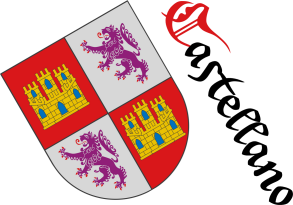
Alfonso VIII of Castile
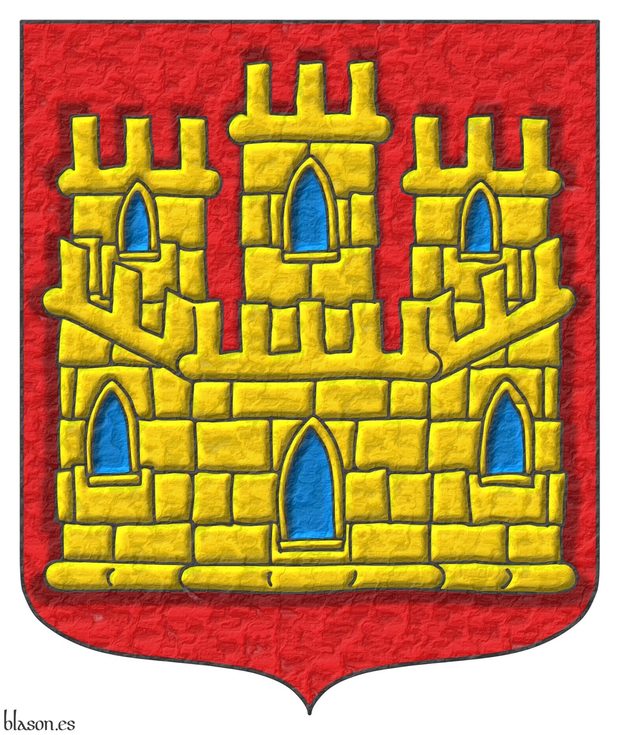
Born on November 11, 1155, in Soria and died on October 6, 1214, in Gutierre-Muñoz, Avila.
Gules, a castle triple towered Or, port and windows Azure, masoned Sable.
Escudo de gules, un castillo de oro, aclarado de azur, mazonado de sable.
Existing arms interpreted by me as follows: the shield’s shape is pointed and rounded; the field has been enameled Gules; the castle is outlined, illuminated, and shaded; the whole composition features a heavily hammered metal finish.
This ancient coat of arms of Castile can be consulted, among other sources, in [Argote de Molina, G.; 1588; chapter XLII].
Blazon keywords: Without divisions, Gules, Or, Azure, Sable, One, Castle, Port and windows and Masoned.
Style keywords: Ogee, Illuminated, Shaded, Outlined in sable and Hard metal.
Classification: Interpreted, Personal, Coat of arms and Kingdom of Castile.
Bearer: Alfonso VIII of Castile.


Alfonso VIII of Castile, royal crown
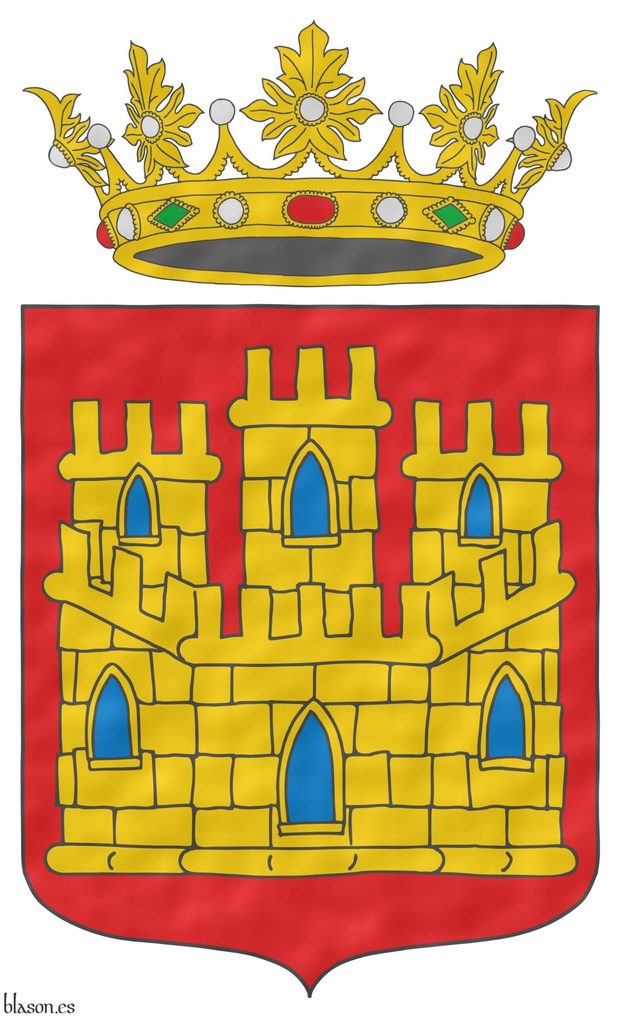
King of Castile from 1158 to 1214.
Gules, a castle triple towered Or, port and windows Azure, masoned Sable. Crest: An open royal crown Or.
Escudo de gules, un castillo de oro, aclarado de azur, mazonado de sable. Timbrado de una corona real abierta.
Arms of the king, as interpreted by me, as follows: the shield's shape is pointed and rounded; the field is enameled Gules; the castle is outlined in Sable; and the whole composition features a watercolor finish.
In [Valero de Bernabé, L.; 2009a; page 1] the author specifies the main characteristics of the «Castilian royal castle», which can be summarized as: «with three towers, the middle one taller, and the two flanking it identical», «each tower crowned with three battlements», «one to three doors and one or two pointed windows on each tower», and «masoned and battlemented», as also noted by the same author in [Valero de Bernabé, L.; 2009b; page 33].
Blazon keywords: Without divisions, Gules, Or, Azure, Sable, One, Castle, Port and windows, Masoned, Crest, Open royal crown and Crown.
Style keywords: Ogee, Plain tincture, Outlined in sable and Watercolor.
Classification: Interpreted, Personal, Coat of arms and Kingdom of Castile.
Bearer: Alfonso VIII of Castile.


Berenguela of Castile
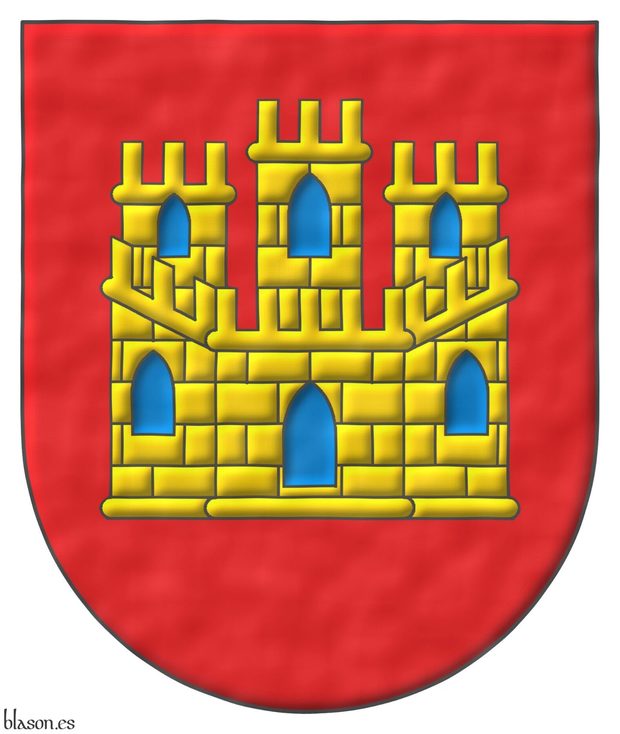
Born in 1179 in Segovia and died on November 8, 1246 in the Monastery of Las Huelgas in Burgos.
Gules, a castle triple towered Or, port and windows Azure, masoned Sable.
Escudo de gules, un castillo de oro, aclarado de azur, mazonado de sable.
Arms of the Queen of Castile, as interpreted by me: the shape of the shield is rounded; the field and the castle have been enamelled and illuminated; and the whole composition features a watercolor finish.
Blazon keywords: Without divisions, Gules, Or, Azure, Sable, One, Castle, Port and windows and Masoned.
Style keywords: Semi-circular, Illuminated, Outlined in sable and Watercolor.
Classification: Interpreted, Personal, Coat of arms and Kingdom of Castile.
Bearer: Berenguela of Castile.


Berenguela of Castile and Alfonso IX
[ Argent, a lion rampant Purpure, armed and langued Gules ] accolé with [ Gules, a castle triple towered Or, port and windows Azure, masoned Sable ].
[ Escudo de plata, un león rampante de púrpura, armado y lampasado de gules ] acolado de un [ escudo de gules, un castillo de oro, aclarado de azur, mazonado de sable ].
Arms of the King of Leon and Queen of Castile, as interpreted by me with: the two shields shaped with rounded arches; the fields of both coat of arms, the lion, and the castle illuminated; and the whole composition featuring a watercolor finish.
Representation of the coats of arms of Alfonso IX of León and Berenguela of Castile as accolé arms ~ «escudos acolados». King Ferdinand III created his coat of arms, based on the coats of arms of his parents, through the marshalling of their arms ~ «composición de sus armas». For this purpose, the saintly king invented a type of composition, which later became widely used, known as quarterly ~ «cuartelado». Other ways to combine the coats of arms of two spouses are:
- Creating a new dimidiated shield ~ «dimidiado».
- Creating a new impaled shield ~ «partido».
- Adding one coat of arms to another as an escutcheon of pretence ~ «escusón de pretensión», in this case, rather than a claim, there was full ownership.
Blazon keywords: Without divisions, Argent, Purpure, Gules, One, Lion, Rampant, Armed, Langued, Or, Azure, Sable, Castle, Port and windows and Masoned.
Style keywords: Semi-circular, Outlined in sable, Tilted shield and Watercolor.
Classification: Interpreted, Personal, Accolé arms, Kingdom of Castile and Kingdom of León.
Bearer: Berenguela of Castile.


Ferdinand III, invention of quartering
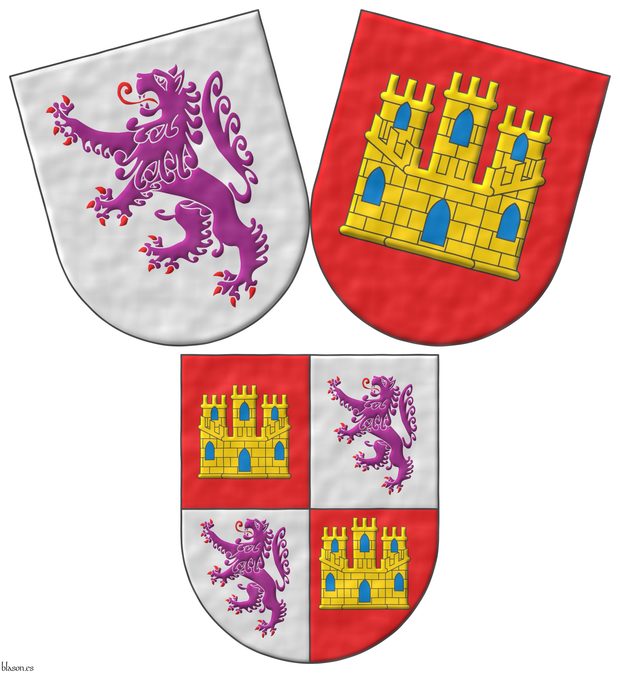
Quarterly: 1 and 4 Gules, a castle triple towered Or, port and windows Azure, masoned Sable; 2 and 3 Argent, a lion rampant Purpure, armed and langued Gules.
Escudo cuartelado: 1o y 4o de gules, un castillo de oro, aclarado de azur, mazonado de sable; 2o y 3o de plata, un león rampante de púrpura, armado y lampasado de gules.
A symbolic image representing, through 3 coats of arms, the creation of the coat of arms of the King Ferdinand III the Saint from the arms of Alfonso IX, King of León, and Berenguela, Queen of Castile. The shapes of all three shields are rounded; all their components are illuminated; and the whole composition features a watercolor finish.
Ferdinand III the Saint was the son of Alfonso IX of León and Berenguela of Castile. During his reign, the crowns of Castile and León were united forever. When, in 1230, Ferdinand III succeeded his father, he adopted a quarterly coat of arms, placing his mother's arms, the castle, in the 1st and 4th quarters, and his father's arms, the lion, in the 2nd and 3rd quarters. His goal was likely to achieve balance between the two kingdoms and to give his coat of arms a greater sense of continuity over time compared to impaled arms. The coat of arms of Ferdinand III the Saint was the first quarterly shield in history, and the idea spread into the heraldry of Spain and other kingdoms, such as Aragon-Sicily, Brabant, England, Navarre, and Bohemia.
The mother first, schematic in English
Blazon keywords: Quarterly, Gules, Or, Azure, Sable, One, Castle, Port and windows, Masoned, Argent, Purpure, Lion, Rampant, Armed, Langued, Crest, Open royal crown and Crown.
Style keywords: Semi-circular, Illuminated, Tilted shield and Watercolor.
Classification: Interpreted, Personal, Accolé arms, Family tree, Genealogical, Kingdom of Castile, Kingdom of León and Kingdom of Castile and Leon.
Bearer: Ferdinand III of Castile.


Leonor Plantagenet and Alfonso VIII
[ Gules, a castle triple towered Or, port and windows Azure, masoned Sable ] accolé with [ Gules, three lions, passant, guardant, in pale Or, armed and langued Azure ].
[ Escudo de gules, un castillo de oro, aclarado de azur, mazonado de sable ] acolado de un [ escudo de gules, tres leopardos en palo de oro, armados y lampasados de azur ].
Arms of the King and Queen of Castile interpreted with: the escutcheons' shapes pointed and rounded; the field of each shield, the castle, and the three leopards enamelled in flat tints of Gules and metal Or, with windows, claws, and tongues in Azure; and the whole composition finished with a raised line technique.
[Medél, R.; 1846; page 38] provides a heraldic description of the leopard.
Blazon keywords: Without divisions, Gules, Or, Azure, Three, Leopard, Armed, Langued, In pale, Sable, One, Castle, Port and windows and Masoned.
Style keywords: Ogee, Plain tincture, Outlined in sable, Tilted shield and Freehand.
Classification: Interpreted, Personal, Accolé arms, House of Plantagenet, Kingdom of England and Kingdom of Castile.
Bearer: Leonor Plantagenet.


Leonor Plantagenet, corona real abierta
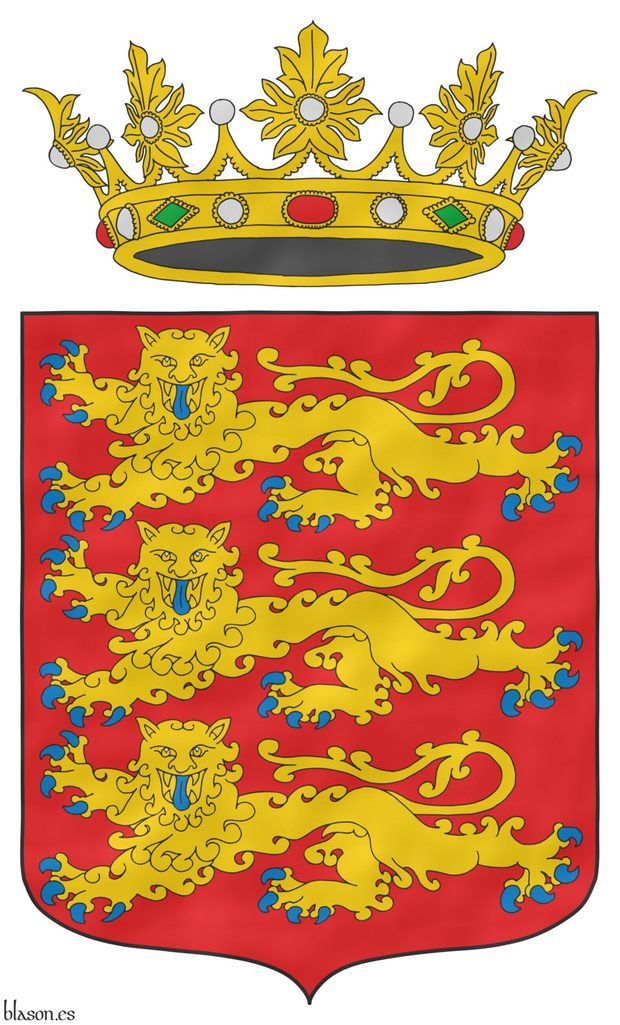
Princess of England and Queen Consort of Castile from 1170 to 1214.
Gules, three lions, passant, guardant, in pale Or, armed and langued Azure. Crest: An open royal crown Or.
Escudo de gules, tres leopardos en palo de oro, armados y lampasados de azur. Timbrado de una corona real abierta.
Armorial bearings of the queen interpreted by me as follows: the shape of the shield is pointed and rounded; both the field, the three leopards, and the open royal crown have been enamelled with flat tints of gules and metal or, with details in azure, vert, and metal argent; the three leopards and the crown are outlined in sable; and the whole composition has a watercolor finish.
She was the daughter of Henry II of England and Eleanor of Aquitaine, wife of Alfonso VIII of Castile, and mother of 10 children documented in historical records, with her eldest daughter being Queen Berenguela of Castile.
Blazon keywords: Without divisions, Gules, Or, Azure, Three, Leopard, Armed, Langued, In pale, Crest, Open royal crown and Crown.
Style keywords: Ogee, Plain tincture, Outlined in sable and Watercolor.
Classification: Interpreted, Personal, Coat of arms, House of Plantagenet, Kingdom of England and Kingdom of Castile.
Bearer: Leonor Plantagenet.


![Ver [Valero de Bernabé, L.; 2009a] en referencias bibliográficas. Libro abierto, hojas de plata, filo de oro, guardas de gules, tapas de sable.](../css/Libro.Bibliografia.png)
Valero de Bernabé, L.; 2009a
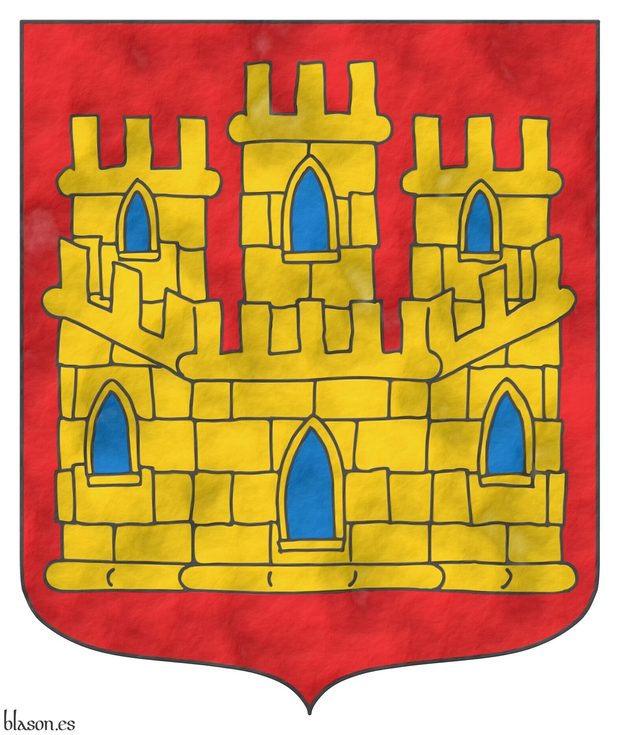
Luis Valero de Bernabé y Martín de Eugenio, «Los Castillos en la Heráldica Española», 2009.
I received this article directly from the author, to whom I am grateful for his kind submission. I consider it a preliminary and preparatory work for the article [Valero de Bernabé, L.; 2009b; pages 32-34] published later.
Bibliographical reference of century XXI.
The author is Valero de Bernabé y Martín de Eugenio, Luis.
Bibliographic reference mentioned in the following articles:
Internal resources: ValeroBernabeL2009.ElCastilloEnLaHeraldicaEspañola.pdf.
-
Language
-
Categories of heraldry
-
Divisions of the field
- Without divisions
- Party per pale
- Party per fess
- Party per bend
- Party per bend sinister
- Tierce
- Tierce sinister
- Tierced per pale
- Tierced per fess
- Tierced per bend
- Tierced pallwise inverted
- Quarterly
- Quarterly per saltire
- Gyronny
- Party per fess, the chief per pale
- Party per pale, the sinister per fess
- Party per fess, the base per pale
- Party per pale, the dexter per fess
- Chapé
- Chaussé
- Embrassé
- Contre-embrassé
- Party per chevron
- Enté
- Enté en point
- Flanched
-
Metals
-
Colours
-
Furs
-
Other tinctures
-
Ordinaries and sub-ordinaries
-
Diminutives of the ordinaries
-
Other charges
-
Inanimate charges from Nature
Atom, Crescent, Diamond, Emerald, Estoile, Increscent, Lightning flash, Moon, Mount, Mullet, Mullet of four points, Orbital, Plough of Ursa Major, Rainbow, Ray of the sun, River, Sea, Snowflake, Sun, Sun in splendour, Sun of May, Trimount and Water.
-
Vegetal charges from Nature
Acorn, Apple, Apple tree, Ash, Bluebonnet, Camellia, Chrysanthemum, Cinquefoil, Cornflower, Dogwood flower, Double rose, Elm, Fleur de lis, Flower, Holm oak, Hop cone, Kapok tree, Laurel, Lily, Linden, Lotus flower, Madonna lily, Oak, Olive tree, Palm tree, Pomegranate, Poplar leaf, Rose, Shamrock, Sunflower, Thistle, Tree, Tulip, Vine and Wheat.
-
Animal charges from Nature
Badger, Bald eagle, Barbel, Barn owl, Bear, Beaver, Beetle, Bighorn sheep, Blackbird, Boar, Brach hound, Bull, Doe, Dog, Dolphin, Dove, Eagle, Elephant, Falcon, Fish, Flame, Fly, Fox, Frog, Goat, Goldfinch, Goose, Heron, Horse, Hummingbird, Jaguar, Lark, Leopard, Lion, Lion passant, Lion rampant guardant, Lioness, Lynx, Male figure, Martlet, Merino ram, Owl, Panther, Parrot, Peacock, Pelican, Pelican in her piety, Puffin, Quetzal, Raven, Roe deer, Rooster, Savage, Seagull, Serpent, She-wolf, Stag, Starling, Tyger, Vulture, Warren hound and Wolf.
-
Parts of natural charges
Arm, Beak, Branch, Caboshed, Chest, Claw, Covert, Dorsal fin, Eagle claw, Ermine spot, Escallop, Feather, Foot (palmiped), Foreleg, Forepaw, Hand, Head, Heart, Hoof, Leaf, Neck, Ostrich feather, Palm frond, Paw, Roe deers' attires, Shoulder, Sprig, Stags' attires, Stem, Swallow-tail, Tail, Tail addorsed, Tail fin, Talon, Tooth, Trunk, Trunk (elephant), Two hands clasped, Two wings in vol, Udder, Wheat spike, Wing and Wrist.
-
Artificial charges
Ace of spades, Anchor, Anvil, Arch, Arm vambraced, Armillary sphere, Arrow, Axe, Bell, Bell tower, Beret, Bonfire, Book, Bookmark, Bow, Bridge, Broken, Buckle, Cannon, Cannon dismounted, Cannon port, Canopy roof, Carbuncle, Castle, Celtic Trinity knot, Chain, Chess rooks, Church, Clarion, Clay pot, Closed book, Club, Comb, Compass rose, Conductor's baton, Cord, Covered cup, Crozier, Crucible, Cuffed, Cup, Cyclamor, Dagger, Double vajra, Drum, Ecclesiastical cap, Fanon, Federschwert, Fleam, Four crescents joined millsailwise, Galician granary, Garb, Gauntlet, Geometric solid, Grenade, Halberd, Hammer, Harp, Host, Hourglass, Key, Key ward, Knight, Knot, Lantern, Letter, Line, Loincloth, Menorah, Millrind, Millstone, Millwheel, Monstrance, Mortar, Mullet of six points pierced, Nail, Non-classic artifact, Norman ship, Number, Oar, Oil lamp, Open book, Page, Pair of scales, Parchment, Pestle, Piano, Plough share, Polish winged hussar, Port, Portcullis, Potent, Quill, Ribbon, Rosette of acanthus leaves, Sabre, Sackbut, Sail, Scroll, Scythe, Sheaf of tobacco, Ship, Skirt, Spear, Spear's head, Stairway, Star of David, Step, Sword, Symbol, Tetrahedron, Torch, Tower, Trident, Trumpet, Turret, Two-handed sword, Wagon-wheel, Water-bouget, Wheel, Winnowing fan and With a turret.
-
Immaterial charges
Angel, Archangel, Basilisk, Dragon, Dragon's head, Garuda, Golden fleece, Griffin, Heart enflamed, Mermaid, Our Lady of Mercy, Ouroboros, Paschal lamb, Pegasus, Phoenix, Sacred Heart of Jesus, Saint George, Sea-griffin, Trinity, Triton, Unicorn, Winged hand and Wyvern.
-
External elements
-
Heraldic creations
-
References
-
Formats
-
Keywords on this page
Port and windows, Watercolor, Alfonso VIII of Castile, Armed, Azure, Berenguela of Castile, Bibliography, House of Plantagenet, Castle, Crest, Ogee, Crown, Open royal crown, Quarterly, Outlined in sable, In pale, Coat of arms, Accolé arms, Ferdinand III of Castile, Genealogical, Personal, Gules, Illuminated, Interpreted, Langued, Leonor Plantagenet, Leopard, Lion, Masoned, Semi-circular, Hard metal, Or, Argent, Without divisions, Purpure, Rampant, Kingdom of Castile, Kingdom of Castile and Leon, Kingdom of England, Kingdom of León, Tilted shield, Sable, Century XXI, Shaded, Plain tincture, Freehand, Three, One and Family tree.

![Berenguela of Castile and Alfonso IX [ Argent, a lion rampant Purpure, armed and langued Gules ] accolé with [ Gules, a castle triple towered Or, port and windows Azure, masoned Sable ].](../escudo_armas/BerenguelaC.23.Matrimonio.jpg)
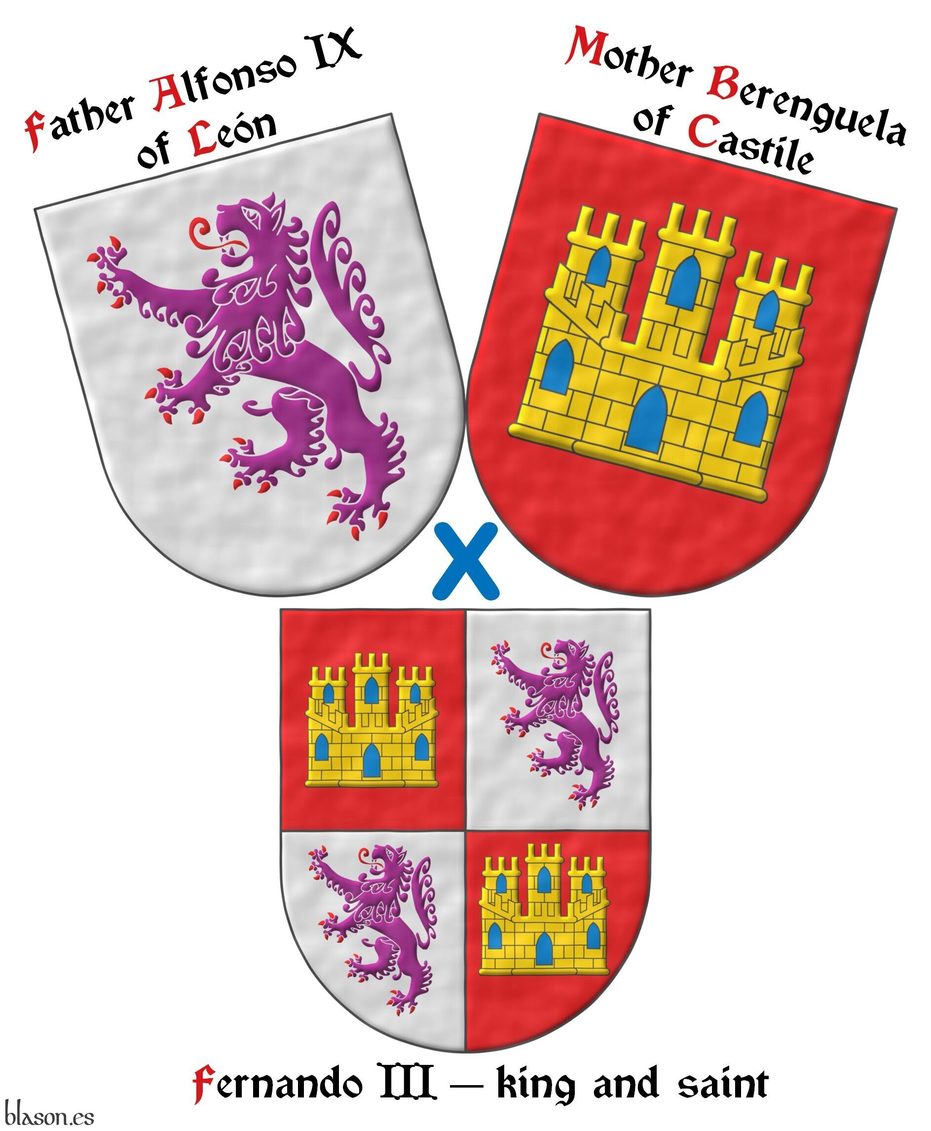
![Leonor Plantagenet and Alfonso VIII [ Gules, a castle triple towered Or, port and windows Azure, masoned Sable ] accolé with [ Gules, three lions, passant, guardant, in pale Or, armed and langued Azure ].](../escudo_armas/LeonorP.23.Matrimonio.jpg)